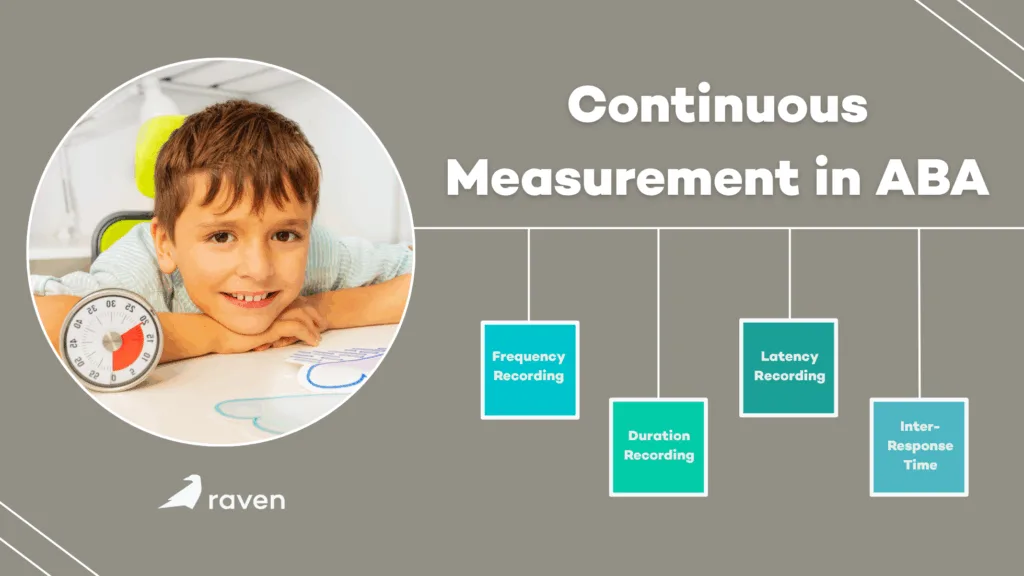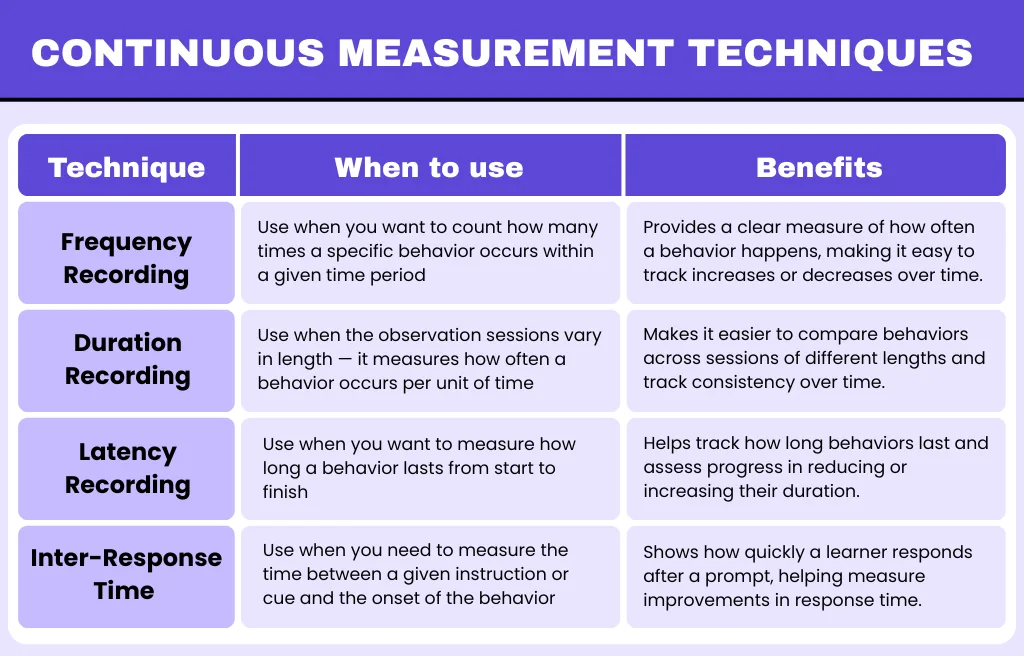
Continuous measurement is a data‑collection method in Applied Behavior Analysis where every occurrence of a target behavior is recorded during a set period. In simple terms, this means an ABA therapist (such as a BCBA or RBT) notes each time the behavior happens. For example, counting every time a child raises their hand or timing the length of a tantrum.
In this article, you will explore the difference between continuous measurement and discontinuous methods, the main techniques used in continuous measurement, and its significance for accurate data collection and progress tracking.
What is Continuous Measurement in ABA?
Applied Behavior Analysis relies on careful data collection to track and change behavior. Continuous measurement means recording every occurrence of a target behavior during an observation period. For example, with continuous recording, a therapist would note all of a student’s temper tantrums during a session. Thus, continuous recording gives a full, detailed account of the behavior.
This thorough tracking helps therapists see patterns and evaluate progress: it provides a detailed and comprehensive view of what’s happening and ensures that no instances are overlooked. In other words, continuous data gives ABA teams the accurate, reliable information they need to make informed treatment decisions.
Continuous vs. Discontinuous Measurement
The choice between continuous and discontinuous methods depends on the situation and behavior. Continuous methods produce the most accurate data because nothing is missed. However, they require more time and attention.
Discontinuous measurement (like partial or whole interval recording) is less demanding but only gives approximate data. In practice, ABA professionals select the method that best fits the behavior and resources.
For example, if you need a complete record of every occurrence (such as during an initial assessment or when behaviors are quick and frequent), continuous measurement is preferred.
Continuous Measurement Techniques
Several specific techniques fall under continuous measurement. Each tracks behavior in a different way:
1. Frequency (Event Recording)
Frequency measurement simply counts how many times a behavior happens. The observer tallies each occurrence during a session (using marks, counters, or beads). This is useful when the behavior has a clear beginning and end, such as raising a hand or throwing a toy.
For example, if you want to know how often a child raises their hand to answer questions, you would record each hand raise as it occurs. Frequency data are easy to collect and analyze, and they give a straightforward measure of how often a behavior occurs.
When to use frequency: Discrete, countable behaviors with clear starts and stops (i.e., number of questions asked, times out of seat). Record each instance as it happens.
Benefits: Simple and direct; shows exact count of behavior occurrences.
Limitation: Does not account for how long each instance lasts, and on its own can be misleading if session lengths vary greatly.
2. Duration Recording
Duration measurement records how long each instance of a behavior lasts from start to finish. The observer uses a stopwatch or timer to measure the length of each occurrence. This technique is ideal for behaviors where total time matters, such as tantrums, time spent on-task, or any continuous activity.
For example, a therapist might time how long a student stays focused on a task or how many seconds a tantrum lasts. By capturing the duration, practitioners can see not just how often the behavior happens, but how long each episode is.
When to use duration: Behaviors with indefinite length or no clear countable instances (i.e., time spent in tantrum, continuous hitting). Use when you want the total time measured.
Benefits: Provides insight into intensity or severity (longer durations may indicate more severe behavior).
Limitation: Requires watching behavior continuously to time start and end; can be difficult if multiple behaviors overlap.
3. Latency Recording
Latency measures the time between a prompt (or signal) and the start of the behavior. In practice, you start a timer when you give a cue (like an instruction or signal) and stop it when the person begins to respond. Latency is useful for evaluating response speed.
For example, if a teacher asks a question and the student takes 5 seconds to start answering, those 5 seconds are the latency. This helps practitioners know if responses are too slow or if they occur too quickly, and adjust teaching strategies accordingly.
When to use latency: When the timing of a response is important (i.e., time from instruction to beginning of task). Useful in teaching programs where you want to decrease response delay.
Benefits: Pinpoints reaction time, helping track improvements in response speed or identify delays.
Limitation: Only captures the first response after each prompt, so it’s not useful for behaviors that happen without a clear cue.
4. Inter-Response Time (IRT)
Inter-response Time (IRT) measures the time between consecutive occurrences of the same behavior. It is the interval from the end of one instance until the start of the next. This shows how quickly a person repeats a behavior.
For example, IRT might be used to measure the time between bites during a meal or between questions asked by a student. Short IRT means the behavior is happening frequently (rapid pace), while long IRT indicates slower occurrence.
A behavior analyst might use IRT to speed up a desired behavior (by decreasing IRT) or to slow down an undesired one (by increasing IRT).
When to use IRT: When the pattern of repeated behavior is of interest (i.e., how much time passes between consecutive problems solved or between episodes of a behavior).
Benefits: Highlights the pacing of behavior, useful for tasks that involve multiple steps or repeated actions.
Limitation: Requires a clear end of one response and start of the next; not applicable if behaviors don’t occur in sequences.
Importance of Continuous Measurement
Continuous data are valued because they give the clearest and most precise picture of behavior. By capturing every instance, continuous measurement methods produce the most accurate data.
This comprehensive recording means analysts don’t miss rare or brief occurrences, which can be overlooked by sampling methods. As a result, continuous measurement allows practitioners to see detailed trends.
With continuous data, therapists can track exactly how a behavior changes over time and in response to intervention. For example, a therapist can plot each session’s total occurrences and see if an intervention is reducing the behavior. This level of detail is crucial for evaluating if goals are being met.
In fact, continuous tracking often yields more reliable progress monitoring; it helps ABA professionals assess whether a treatment plan is working and make timely adjustments.
Since continuous recording collects all data, it reduces bias and ensures that even subtle improvements or worsening of behavior are noticed. For these reasons, continuous measurement is preferred when accuracy is critical, such as during initial assessments or when closely monitoring an intervention’s effects.
When Is Continuous Measurement Preferred?
Continuous measurement is best suited to situations where a full record of behavior is important. For example:
High-Frequency Behaviors
When a behavior happens often (i.e., a student raising their hand many times in class), continuous recording captures each instance. This gives an accurate count of how engaged the student is.
Long-Duration Behaviors
For behaviors that last a while (like a tantrum or extended on-task work), continuous measurement tracks exactly how long each episode lasts. Knowing the duration is key to understanding severity or focus level.
Precise, Data-Driven Decisions
In early stages of therapy or research, clinicians use continuous tracking to establish detailed baselines. By establishing clear goals based on documented behaviors and observing every occurrence, therapists can monitor progress accurately and adjust plans in real time.
One-on-One Settings
When a therapist works with one person (so full attention is possible), continuous methods are practical even for relatively rare behaviors. Capturing each instance (even if infrequent) provides a complete picture, which can be vital when tailoring interventions.
Conclusion
Continuous measurement is the method of choice when you need exact data on how often or how long a behavior occurs. It is most practical for discrete, countable behaviors and for capturing the full extent of an action. When used appropriately, continuous data collection lets ABA professionals track changes and progress with confidence, ensuring interventions are based on solid evidence.
